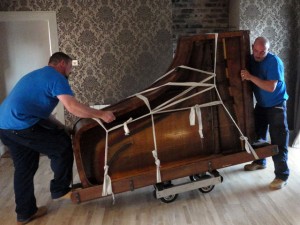 Print a Sign-In Sheet | Spanish Version
Print a Sign-In Sheet | Spanish Version
Proper lifting techniques are proven to reduce painful and costly back injuries.
Here are some basic “lifting lessons” that will help save your back.
- Keep the path you’ll be taking is free of obstructions or slip hazards.
- Face the load you are trying to lift.
- Check the load’s weight before you try to lift it, and also ensure the load won’t shift.
- Know your lifting ability and get help with heavy or awkward loads
- Bend at the knees with your feet approximately shoulders’ width apart, one foot slightly ahead of the other.
- Grasp the load and gain control before you attempt the lift.
- Look up just before you lift. This helps keep your head, neck and back aligned correctly.
- Lift gradually with your legs, not your back; don’t jerk the load.
- Inhale deeply and then breathe out as you lift.
- Keep your upper back and shoulders straight as you lift.
- Keep the load close to your body.
- Watch for pinch points, when you set the load down.
- Pace yourself, you stand less chance of getting tired and sloppy with your lifting technique. Take your time when lifting and carrying objects.
- Move your feet to turn your body. Don’t twist at the waist when lifting or carrying a load. Instead.
- Push objects, don’t pull! Pulling usually requires you to twist your back to watch where you are going.
To put the load down, just reverse the steps, lowering with your legs, placing your feet in the proper position and keeping the load close to your body.
Gentle stretching of your legs and back and toning your abdominal muscles are important in keeping your back injury free. Remember, exercise is very important in protecting you back. Please see your physician before starting an exercise program.
To stay healthy and strong, eat well, exercise, rest, and use good judgment. That way, you can keep the 400 muscles, 1,000 tendons, 31 pairs of nerves, and 33 vertebrae of your back pain-free and in working order.
KEMI does not assume liability for the content of information contained herein. Safety and health remain your responsibility. This information is to be used for informational purposes only and not intended to be exhaustive or a substitute for proper training, supervision or manufacturers’ instructions/recommendations. KEMI, by publication of this information, does not assume liability for damage or injury arising from reliance upon it. Compliance with this information is not a guarantee or warranty that you will be in conformity with any laws or regulations nor does it ensure the absolute safety of any person, place or object, including, but not limited to, you, your occupation, employees, customers or place of business.

